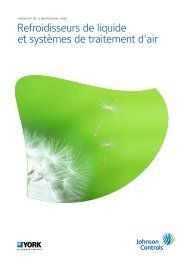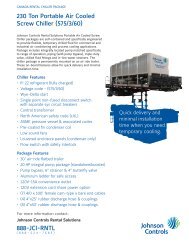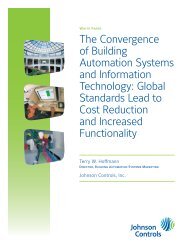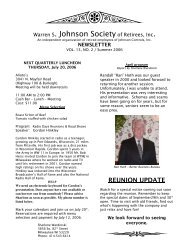Rxf - Johnson Controls Inc.
Rxf - Johnson Controls Inc.
Rxf - Johnson Controls Inc.
You also want an ePaper? Increase the reach of your titles
YUMPU automatically turns print PDFs into web optimized ePapers that Google loves.
GROUNDING<br />
Grounding is the most important factor for successful operation<br />
and is typically the most overlooked. The NEC states that<br />
control equipment may be grounded by using the rigid conduit<br />
as a conductor. This worked for the earlier relay systems, but<br />
it is in no way acceptable for electronic control equipment.<br />
Conduit is made of steel and is a poor conductor relative<br />
to an insulated stranded copper wire. Electronic equipment<br />
reacts to very small currents and must have a proper ground<br />
in order to operate properly; therefore, stranded copper<br />
grounds are required for proper operation.<br />
For proper operation, the control power ground circuit must<br />
be a single continuous circuit of the proper sized insulated<br />
stranded conductor, from the electronic control panel to the<br />
plant supply transformer (Figure 38). Driving a ground stake<br />
at the electronic control may also cause additional problems<br />
since other equipment in the plant on the same circuits may<br />
ground themselves to the ground stake causing large ground<br />
flow at the electronic control panel. Also, running multiple<br />
ground conductors into the electronic control panel from<br />
various locations can create multiple potentials resulting in<br />
ground loop currents. A single ground wire (10 AWG or 8<br />
AWG) from the electronic control panel, that is bonded to the<br />
control power neutral at the secondary side of the control<br />
power transformer in the starter and then to the 3-phase<br />
ground point, will yield the best results.<br />
Figure 38<br />
NOTE: Structural grounding can also result in multiple<br />
ground potentials and is also a relatively poor conductor.<br />
Therefore, this is not an acceptable method for proper<br />
operation of electronic equipment.<br />
There must be a ground for the three-phase power wiring.<br />
This must be sized in accordance to the NEC and any local<br />
codes relative to the highest rated circuit overload protection<br />
provided in the circuit. The manufacturer may require a<br />
larger ground conductor than what is required by the NEC for<br />
proper steering of EMI from sensitive circuits. This conductor<br />
must also be insulated to avoid inadvertent contact at<br />
multiple points to ground, which could create Ground Loops.<br />
In many installations that are having electronic control problems,<br />
this essential wire is usually missing, is not insulated,<br />
or improperly sized.<br />
RXF ROTARY SCREW COMPRESSOR UNITS<br />
PROPER INSTALLATION OF ELECTRICAL EQUIPMENT<br />
070.410-IOM (JUL 11)<br />
Page 49<br />
NEC size ratings are for safety purposes and not necessarily<br />
for adequate relaying of noise (EMI) to earth ground to avoid<br />
possible interference with sensitive equipment. Therefore<br />
sizing this conductor 1 – 2 sizes larger than required by code<br />
will provide better transfer of this noise.<br />
Frick requirements for the ground conductor are:<br />
• Stranded Copper<br />
• Insulated<br />
• One size larger than NEC requirements for conventional<br />
starters<br />
• Two sizes larger than NEC requirements for VFD starters<br />
• Conduit must be grounded at each end<br />
• This circuit must be complete from the motor to the<br />
starter continuing in a seamless manner back to the plant<br />
supply transformer (power source).<br />
For Direct Coupled, Package Mounted Starters, the ground<br />
between the motor and the starter may need to be made<br />
externally (Figure 39). The connection on the starter end<br />
must be on the starter side of the vibration isolators. Be<br />
certain the connection is metal to metal. Paint may need<br />
to be removed to ensure a proper conductive circuit. The<br />
use of counter-sunk star washers at the point of connection<br />
at each end will maximize metal to metal contact.<br />
Figure 39<br />
VFD APPLICATIONS<br />
The primary ground conductor that accompanies the threephase<br />
supply must be stranded copper, insulated and two<br />
sizes larger than the minimum required by the NEC or any<br />
other applicable codes. This is necessary due to the increased<br />
generation of EMI which is a characteristic of a VFD output<br />
to the motor when compared to a conventional starter.<br />
For VFD applications, isolation of the control power, analog<br />
devices, and communications ground from the 3-phase<br />
ground within the starter and the electronic control panel may<br />
be necessary. This is due to the higher noise (RFI/EMI) levels<br />
generated between the VFD output and the motor, relative<br />
to a conventional starter. If these grounds are left coupled<br />
by a common back-plate in the starter/drive, this noise can<br />
be direct coupled to the control power, analog device, and<br />
communications grounding and may cause unexplained<br />
behavior and possible damage to components.










![[PDF] Intelligent Fire Annunciator IFA-1000 - Johnson Controls Inc.](https://img.yumpu.com/7424420/1/190x245/pdf-intelligent-fire-annunciator-ifa-1000-johnson-controls-inc.jpg?quality=85)





